Urothelial organoids originating from Cd49fhigh mouse stem cells display Notch-dependent differentiation capacity
- PMID: 31562298
- PMCID: PMC6764959
- DOI: 10.1038/s41467-019-12307-1
Urothelial organoids originating from Cd49fhigh mouse stem cells display Notch-dependent differentiation capacity
Abstract
Understanding urothelial stem cell biology and differentiation has been limited by the lack of methods for their unlimited propagation. Here, we establish mouse urothelial organoids that can be maintained uninterruptedly for >1 year. Organoid growth is dependent on EGF and Wnt activators. High CD49f/ITGA6 expression features a subpopulation of organoid-forming cells expressing basal markers. Upon differentiation, multilayered organoids undergo reduced proliferation, decreased cell layer number, urothelial program activation, and acquisition of barrier function. Pharmacological modulation of PPARγ and EGFR promotes differentiation. RNA sequencing highlighted genesets enriched in proliferative organoids (i.e. ribosome) and transcriptional networks involved in differentiation, including expression of Wnt ligands and Notch components. Single-cell RNA sequencing (scRNA-Seq) analysis of the organoids revealed five clusters with distinct gene expression profiles. Together, with the use of γ-secretase inhibitors and scRNA-Seq, confirms that Notch signaling is required for differentiation. Urothelial organoids provide a powerful tool to study cell regeneration and differentiation.
Conflict of interest statement
The authors declare no competing interests.
Figures
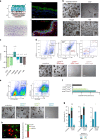


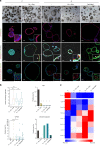
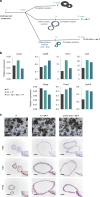

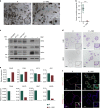
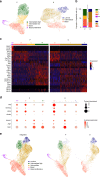
Similar articles
-
Tripartite interactions between Wnt signaling, Notch and Myb for stem/progenitor cell functions during intestinal tumorigenesis.Stem Cell Res. 2014 Nov;13(3 Pt A):355-66. doi: 10.1016/j.scr.2014.08.002. Epub 2014 Sep 28. Stem Cell Res. 2014. PMID: 25290188
-
Shh agonist enhances maturation in homotypic Lgr5-positive inner ear organoids.Theranostics. 2025 Apr 13;15(12):5543-5565. doi: 10.7150/thno.107345. eCollection 2025. Theranostics. 2025. PMID: 40365278 Free PMC article.
-
Induced Quiescence of Lgr5+ Stem Cells in Intestinal Organoids Enables Differentiation of Hormone-Producing Enteroendocrine Cells.Cell Stem Cell. 2017 Feb 2;20(2):177-190.e4. doi: 10.1016/j.stem.2016.11.001. Epub 2016 Dec 8. Cell Stem Cell. 2017. PMID: 27939219
-
Single Cell Sequencing and Kidney Organoids Generated from Pluripotent Stem Cells.Clin J Am Soc Nephrol. 2020 Apr 7;15(4):550-556. doi: 10.2215/CJN.07470619. Epub 2020 Jan 28. Clin J Am Soc Nephrol. 2020. PMID: 31992574 Free PMC article. Review.
-
Multiplexed single-cell analysis of organoid signaling networks.Nat Protoc. 2021 Oct;16(10):4897-4918. doi: 10.1038/s41596-021-00603-4. Epub 2021 Sep 8. Nat Protoc. 2021. PMID: 34497385 Review.
Cited by
-
Recurrent exon-deleting activating mutations in AHR act as drivers of urinary tract cancer.Sci Rep. 2022 Jun 16;12(1):10081. doi: 10.1038/s41598-022-14256-0. Sci Rep. 2022. PMID: 35710704 Free PMC article.
-
Does the Urothelium of Old Mice Regenerate after Chitosan Injury as Quickly as the Urothelium of Young Mice?Int J Mol Sci. 2020 May 15;21(10):3502. doi: 10.3390/ijms21103502. Int J Mol Sci. 2020. PMID: 32429113 Free PMC article.
-
Integrative Single Cell Atlas Revealed Intratumoral Heterogeneity Generation from an Adaptive Epigenetic Cell State in Human Bladder Urothelial Carcinoma.Adv Sci (Weinh). 2024 Jun;11(24):e2308438. doi: 10.1002/advs.202308438. Epub 2024 Apr 6. Adv Sci (Weinh). 2024. PMID: 38582099 Free PMC article.
-
Differentiation of a Contractile, Ureter-Like Tissue, from Embryonic Stem Cell-Derived Ureteric Bud and Ex Fetu Mesenchyme.J Am Soc Nephrol. 2020 Oct;31(10):2253-2262. doi: 10.1681/ASN.2019101075. Epub 2020 Aug 21. J Am Soc Nephrol. 2020. PMID: 32826325 Free PMC article.
-
Endometrial Organoids and Their Role in Modeling Human Infertility.Cells. 2025 Jun 3;14(11):829. doi: 10.3390/cells14110829. Cells. 2025. PMID: 40498005 Free PMC article. Review.
References
-
- Wu X-R, Manabe M, Jun Y, Sun T-T. Large scale purification and immunolocalization of bovine uroplakins I, II, and III. J. Biol. Chem. 1990;265:19170–19179. - PubMed
Publication types
MeSH terms
Substances
LinkOut - more resources
Full Text Sources
Medical
Molecular Biology Databases
Research Materials
Miscellaneous

